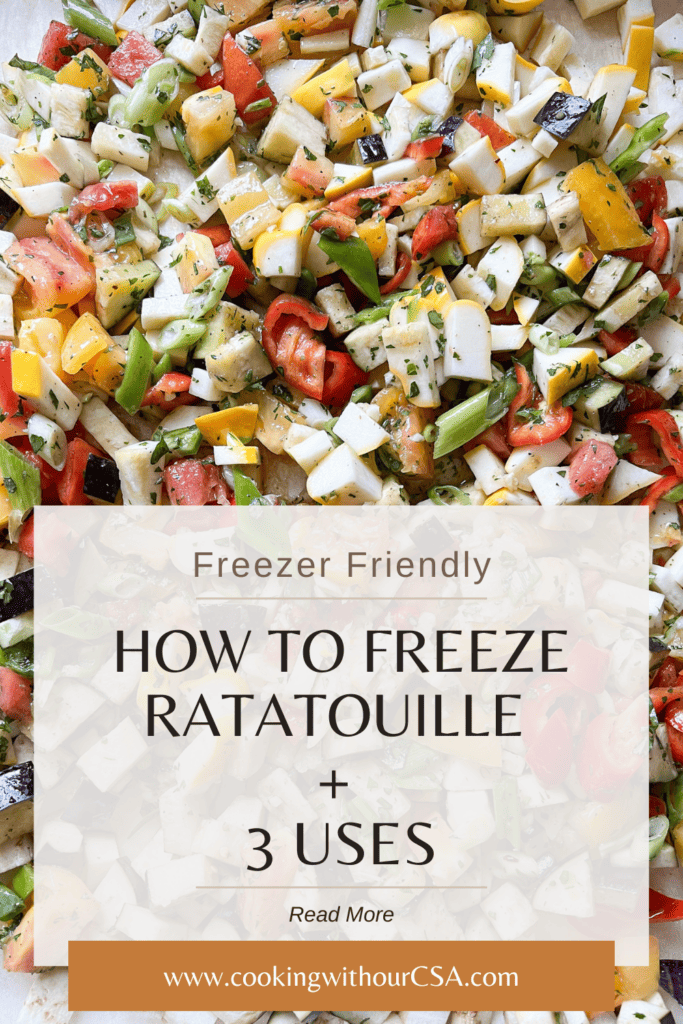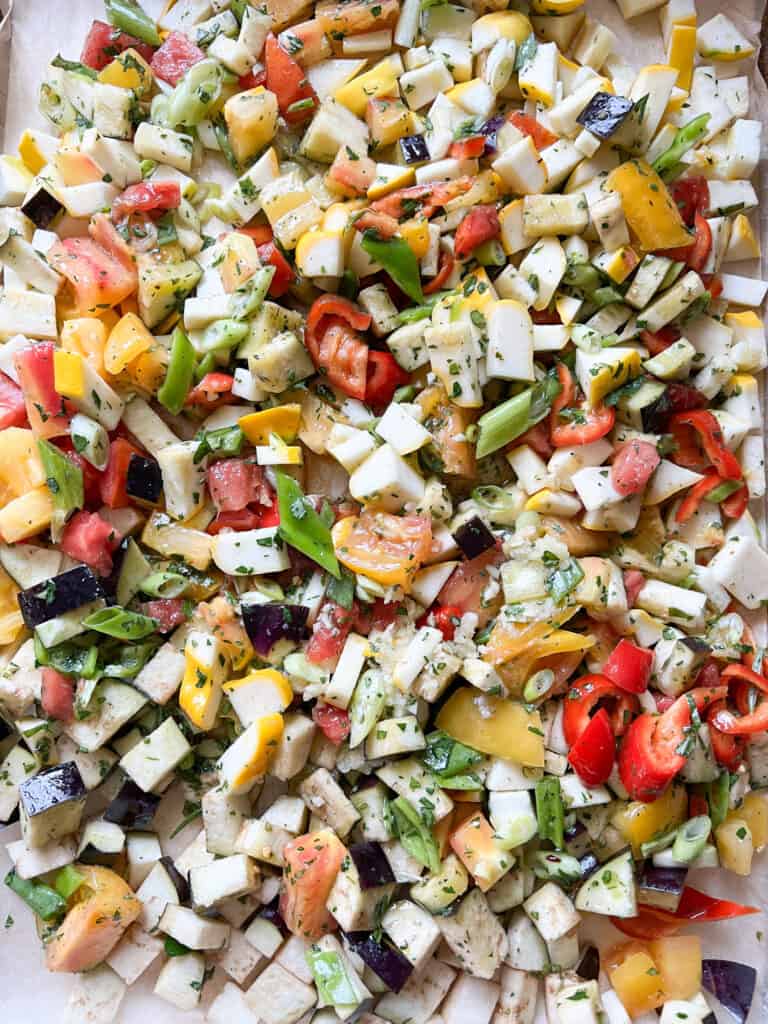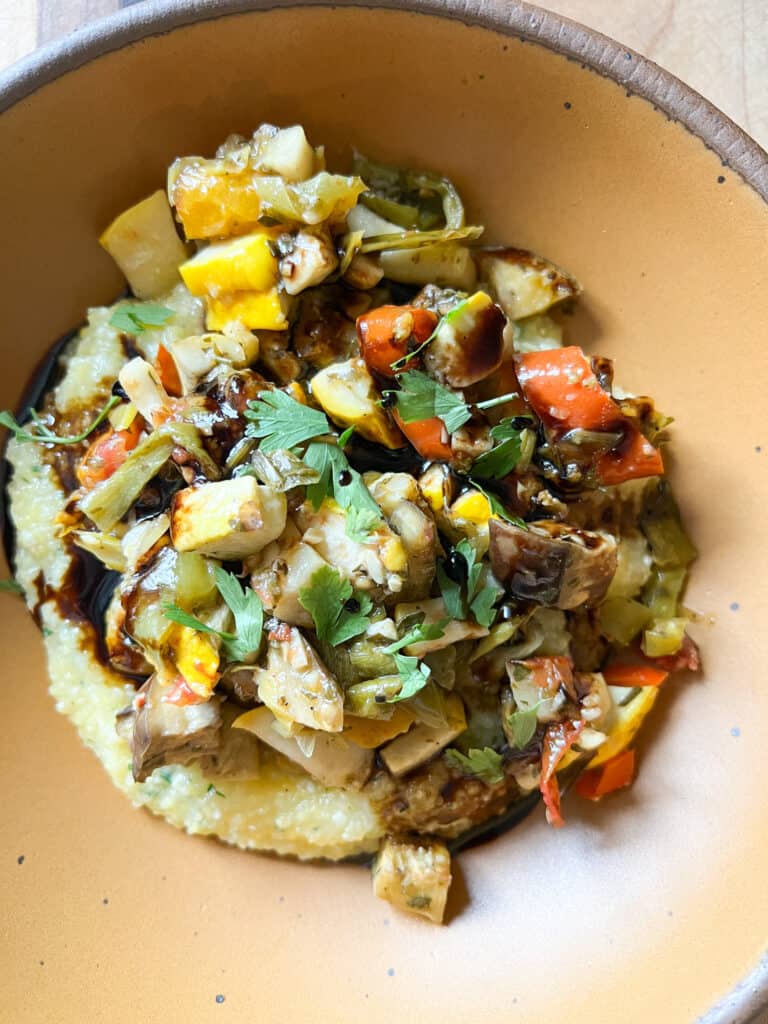When I visit the local farmers market and also peek into our weekly produce CSA box, anytime I see eggplant, tomatoes, and zucchini I immediately think of making the classic Ratatouille dish. I will often wonder: can you freeze ratatouille? As I’ve found out: Yes! Today I’m sharing ways you can freeze ratatouille as a part of freezer friendly batch cooking. I also share three (3) uses for the big batch of slowly roasted fresh vegetables. Each meal idea helps to meet the moment of seasonal cooking.
The Benefits of Freezing Ratatouille
The great thing about making your best Ratatouille recipe is that you can preserve all the fresh flavors of this classic French dish to savor for another night. I particularly love to do this to save the flavors of late summer red bell peppers, baby eggplants, and all the fresh tomatoes and fresh basil that we harvest from our summer garden. I love knowing I can freeze this for up to three months. If I’m freezing a batch in, say, September, then my family and I can enjoy those late summer flavors on a chilly late Autumn evening for dinner.
This easy ratatouille recipe is a delicious seasonal dinner option for an easy meal that’s perfect for late summer vegetables. I love to make a complete meal of this thick vegetable stew by serving it alongside crusty bread. The bread helps to soak up all the delicious sauce from the tomato paste and fresh herbs. Once we’ve taken the time to make this main course filled with a lot of vegetables in our workhorse of a Dutch oven, it’s a great idea to consider freezing a double batch.
Scroll down to see my key tips for freezing your traditional ratatouille recipe to maximize freshness.

How to Freeze Ratatouille
If this is your first time making the traditional French Ratatouille peasant dish, check out my easy recipe here for a recipe card that maximizes all the fresh farmer’s market late summer produce. Once you’ve prepared your perfect dish of roasted red onions, crushed tomatoes, yellow squash, and eggplant, here are the steps to take to freeze your main dish to save for future meals:
Cooling and Portioning Your Ratatouille
- Cool to Room Temperature: Cool your prepared ratatouille to room temperature post bake. This will help avoid creating excess moisture when freezing. Freezing hot liquids or solids before it has a chance to cool we create excess moisture. This can promote freezer burn or ice crystals on the food. Additionally, freezing hot food alongside already frozen food can lead to the frozen food to begin to defrost slightly thereby increasing the chance for food spoilage. This article from Michigan State University offers a great breakdown in how to cool food properly for storage. Oftentimes, I will cool the ratatouille in the refrigerator and then portion it out next day in containers to freeze.
- Portion Servings into an Airtight Container: Portioning the contents of the rustic French vegetable dish is my favorite way to plan out future meals. Layer the contents in a single layer in either freezer-safe containers or freezer gallon ziploc bags. Ensure all excess air is removed from a freezer bag or freezer container.
Labeling and Freezing Ratatouille
- Label and Date: This is always a good idea to do when preserving or saving food for a future meal. Make sure to label the container with the contents and the date. For this ratatouille dish I will label it as: “Ratatoutille: mm/dd/yyyy.” It’s important to include the year depending on the time of year you are freezing it to help in tracking time. If I’m freezing ratatouille in August, for example, I’ll want to make sure that I note the year so that if I’m checking the freezer and see a batch of ratatouille from October in January of the new year (like I did yesterday) then I know to add to our Dinner Plans menu ASAP.
- Freeze: For best results, plan to freeze your Ratatouille for up to 3 months. Freezing a big pot of this vegetable dish is a great practice for meal prepping through the seasons, but it’s important to remember to make a plan to consume anything you’ve planned to freeze or preserve.

Three Uses for a Big Batch of Ratatouille
Ratatouille is truly a versatile dish to include as part of our regular meal planning and prep. The slow roast of chopped onion, fresh garlic, eggplant, zucchini squash, and tomatoes in a little olive oil creates a dish of delicious vegetables that can be used in different ways. Now that we’ve made our great recipe for ratatouille, here are three ideas for using up all the portioned servings made:
- Serve with Crusty Bread: Traditionally serve ratatouille with some of your favorite crusty bread to soak up some of the tomato sauce. This is great when we get the released juices at the bottom of the pan during the end of the cooking process.
- Blend Leftover Ratatouille for Pasta Sauces: This makes for a zesty pasta sauce! It’s perfect with a bit of crushed red pepper flakes and a sprinkle of feta cheese or parmesan cheese. Toss the sauce with your favorite pasta.
- Top On a Bed of Polenta, Mashed Potatoes, or Rice: This batch of ratatouille is great on a bed of herby polenta. Top with a drizzle of syrupy balsamic vinegar. You can top this on a bed of cooked brown or white long grain, or even cauliflower rice.

Seasonal Cooking Made More Delicious
Making a double batch of a recipe and freezing portioned servings for a future meal is one of my go-to practices when it comes to seasonal cooking. I share plenty more tips, meal ideas, and recipes in my weekly newsletter: Dinner Plans. From favorite recipes to new things with a wide variety of ingredients, cooking delicious food with our CSA definitely gets us out of a dinner rut and reduce food waste. Subscribe to my weekly newsletter to be in the know when they’re live. 😉
Happy to answer any additional questions you have about freezing meals like ratatouille in the comments below. In the meantime, cheers to the next nourishing meal. 🧡

Leave a Reply